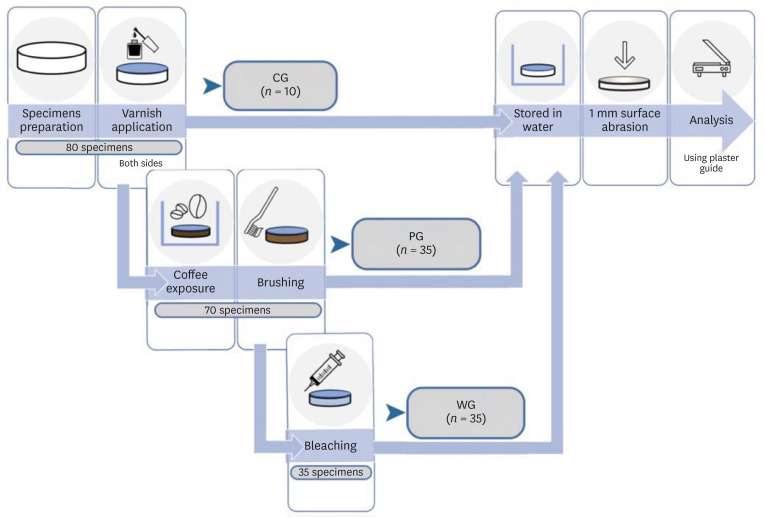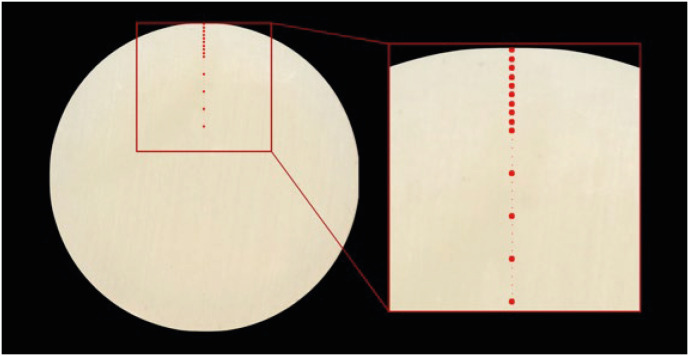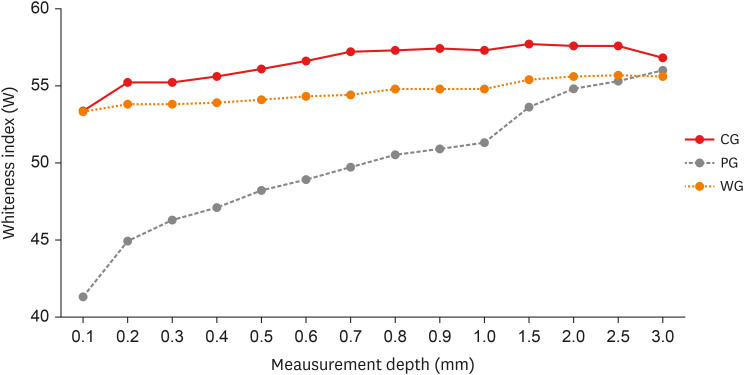Restor Dent Endod.
2024 Aug;49(3):e23. 10.5395/rde.2024.49.e23.
Can discolored dental composites be bleached in depth?
- Affiliations
-
- 1Department of Experimental and Clinical Medicine, Unit of Dentistry, University of Florence, Florence, Italy
- KMID: 2559736
- DOI: http://doi.org/10.5395/rde.2024.49.e23
Abstract
Objectives
Previous in vitro studies determined the whitening effects of bleaching products on stained resin composite surfaces. This in vitro study aimed to verify the effectiveness of a whitening system on composite resin previously subjected to pigmentation, specifically examining the depth of whitening effectiveness within the material structure.
Materials and Methods
A commercially available nano-filled composite resin was used. Specimens were stained using a coffee-based solution and a 10% carbamide peroxide-based gel was employed as the whitening agent. The pigment’s penetration and the effect of the bleaching gel were evaluated by measuring color (CieLab values) from the outer edge to the inner part of the specimens. Color measurements were taken at 14 points, starting from 0.1 mm from the external perimeter up to 3.0 mm.
Results
Analysis of variance tests showed a statistically significant difference between the Control Group (CG), Pigmentation Group, and Whitening Group. The whitening agent was effective up to 1.5 mm in depth, with Whiteness index (W) values not statistically different from those of CG up to 0.5 mm in depth.
Conclusions
Whitening agents on nano-filled resin composite previously pigmented appear effective in restoring the W to values similar to the original, particularly in the superficial layers of the sample.
Keyword
Figure
Reference
-
1. Reinhardt JW, Balbierz MM, Schultz CM, Simetich B, Beatty MW. Effect of tooth-whitening procedures on stained composite resins. Oper Dent. 2019; 44:65–75. PMID: 29570025.2. Attin T, Hannig C, Wiegand A, Attin R. Effect of bleaching on restorative materials and restorations--a systematic review. Dent Mater. 2004; 20:852–861. PMID: 15451241.3. Abd Elhamid M, Mosallam R. Effect of bleaching versus repolishing on colour and surface topography of stained resin composite. Aust Dent J. 2010; 55:390–398. PMID: 21133937.4. Türkün LS, Türkün M. Effect of bleaching and repolishing procedures on coffee and tea stain removal from three anterior composite veneering materials. J Esthet Restor Dent. 2004; 16:290–301. PMID: 15726798.5. Alharbi A, Ardu S, Bortolotto T, Krejci I. In-office bleaching efficacy on stain removal from CAD/CAM and direct resin composite materials. J Esthet Restor Dent. 2018; 30:51–58. PMID: 29130615.6. Mjör IA. The reasons for replacement and the age of failed restorations in general dental practice. Acta Odontol Scand. 1997; 55:58–63. PMID: 9083578.7. Malhotra N, Shenoy RP, Acharya S, Shenoy R, Mayya S. Effect of three indigenous food stains on resin-based, microhybrid-, and nanocomposites. J Esthet Restor Dent. 2011; 23:250–257. PMID: 21806757.8. Mutlu-Sagesen L, Ergün G, Özkan Y, Semiz M. Color stability of a dental composite after immersion in various media. Dent Mater J. 2005; 24:382–390. PMID: 16279728.9. Nasim I, Neelakantan P, Sujeer R, Subbarao CV. Color stability of microfilled, microhybrid and nanocomposite resins--an in vitro study. J Dent. 2010; 38(Supplement 2):e137–e142. PMID: 20553993.10. Topcu FT, Sahinkesen G, Yamanel K, Erdemir U, Oktay EA, Ersahan S. Influence of different drinks on the colour stability of dental resin composites. Eur J Dent. 2009; 3:50–56. PMID: 19262731.11. Alharbi A, Ardu S, Bortolotto T, Krejci I. Stain susceptibility of composite and ceramic CAD/CAM blocks versus direct resin composites with different resinous matrices. Odontology. 2017; 105:162–169. PMID: 27456684.12. Raptis CN, Powers JM, Fan PL, Yu R. Staining of composite resins by cigarette smoke. J Oral Rehabil. 1982; 9:367–371. PMID: 6213749.13. Gujjari AK, Bhatnagar VM, Basavaraju RM. Color stability and flexural strength of poly (methyl methacrylate) and bis-acrylic composite based provisional crown and bridge auto-polymerizing resins exposed to beverages and food dye: an in vitro study. Indian J Dent Res. 2013; 24:172–177. PMID: 23965441.14. Arocha MA, Mayoral JR, Lefever D, Mercade M, Basilio J, Roig M. Color stability of siloranes versus methacrylate-based composites after immersion in staining solutions. Clin Oral Investig. 2013; 17:1481–1487.15. Güler AU, Güler E, Yücel AC, Ertaş E. Effects of polishing procedures on color stability of composite resins. J Appl Oral Sci. 2009; 17:108–112. PMID: 19274395.16. Asmussen E, Hansen EK. Surface discoloration of restorative resins in relation to surface softening and oral hygiene. Scand J Dent Res. 1986; 94:174–177. PMID: 2939546.17. Asmussen E. Factors affecting the color stability of restorative resins. Acta Odontol Scand. 1983; 41:11–18. PMID: 6575570.18. Ruyter IE. Composites--characterization of composite filling materials: reactor response. Adv Dent Res. 1988; 2:122–129. PMID: 3073777.19. Garoushi S, Lassila L, Hatem M, Shembesh M, Baady L, Salim Z, et al. Influence of staining solutions and whitening procedures on discoloration of hybrid composite resins. Acta Odontol Scand. 2013; 71:144–150. PMID: 23256645.20. Ergücü Z, Türkün LS, Aladag A. Color stability of nanocomposites polished with one-step systems. Oper Dent. 2008; 33:413–420. PMID: 18666499.21. Ikeda T, Nakanishi A, Yamamoto T, Sano H. Color differences and color changes in Vita shade tooth-colored restorative materials. Am J Dent. 2003; 16:381–384. PMID: 15002951.22. Ardu S, Braut V, Gutemberg D, Krejci I, Dietschi D, Feilzer AJ. A long-term laboratory test on staining susceptibility of esthetic composite resin materials. Quintessence Int. 2010; 41:695–702. PMID: 20657860.23. Ardu S, Duc O, Di Bella E, Krejci I. Color stability of recent composite resins. Odontology. 2017; 105:29–35. PMID: 26892953.24. Cinelli F, Scaminaci Russo D, Nieri M, Giachetti L. Stain susceptibility of composite resins: pigment penetration analysis. Materials (Basel). 2022; 15:4874. PMID: 35888342.25. Davidi MP, Hadad A, Weiss EI, Domb A, Mizrahi B, Sterer N. The effect of a mild increase in temperature on tooth bleaching. Quintessence Int. 2008; 39:771–775. PMID: 19093051.26. Kwon SR, Wertz PW. Review of the mechanism of tooth whitening. J Esthet Restor Dent. 2015; 27:240–257. PMID: 25969131.27. Wijetunga CL, Otsuki M, Hiraishi N, Luong MN, Tagami J. Effect of pH of bleaching agent on tooth bleaching action in vitro . Dent Mater J. 2021; 40:566–572. PMID: 33456029.28. Torres CR, Crastechini E, Feitosa FA, Pucci CR, Borges AB. Influence of pH on the effectiveness of hydrogen peroxide whitening. Oper Dent. 2014; 39:E261–E268. PMID: 25136903.29. Poggio C, Beltrami R, Scribante A, Colombo M, Chiesa M. Surface discoloration of composite resins: Effects of staining and bleaching. Dent Res J. 2012; 9:567–573.30. Villalta P, Lu H, Okte Z, Garcia-Godoy F, Powers JM. Effects of staining and bleaching on color change of dental composite resins. J Prosthet Dent. 2006; 95:137–142. PMID: 16473088.31. de Camargo EJ, Moreschi E, Baseggio W, Cury JA, Pascotto RC. Composite depth of cure using four polymerization techniques. J Appl Oral Sci. 2009; 17:446–450. PMID: 19936524.32. Durner J, Stojanovic M, Urcan E, Spahl W, Haertel U, Hickel R, et al. Effect of hydrogen peroxide on the three-dimensional polymer network in composites. Dent Mater. 2011; 27:573–580. PMID: 21444108.33. Lago M, Mozzaquatro LR, Rodrigues C, Kaizer MR, Mallmann A, Jacques LB. Influence of bleaching agents on color and translucency of aged resin composites. J Esthet Restor Dent. 2017; 29:368–377. PMID: 27599875.34. Thickett E, Cobourne MT. New developments in tooth whitening. The current status of external bleaching in orthodontics. J Orthod. 2009; 36:194–201. PMID: 19741182.35. Goldberg M, Grootveld M, Lynch E. Undesirable and adverse effects of tooth-whitening products: a review. Clin Oral Investig. 2010; 14:1–10.36. Curtis AR, Palin WM, Fleming GJ, Shortall AC, Marquis PM. The mechanical properties of nanofilled resin-based composites: the impact of dry and wet cyclic pre-loading on bi-axial flexure strength. Dent Mater. 2009; 25:188–197. PMID: 18656255.37. Cavalcante LM, Ferraz LG, Antunes KB, Garcia IM, Schneider LF, Collares FM. Silane content influences physicochemical properties in nanostructured model composites. Dent Mater. 2021; 37:e85–e93. PMID: 33243439.38. Bouschlicher MR, Rueggeberg FA, Boyer DB. Effect of stepped light intensity on polymerization force and conversion in a photoactivated composite. J Esthet Dent. 2000; 12:23–32. PMID: 11323830.39. Duc O, Di Bella E, Krejci I, Betrisey E, Abdelaziz M, Ardu S. Staining susceptibility of resin composite materials. Am J Dent. 2019; 32:39–42. PMID: 30834730.40. Rueggeberg FA, Caughman WF, Curtis JW Jr, Davis HC. Factors affecting cure at depths within light-activated resin composites. Am J Dent. 1993; 6:91–95. PMID: 8397991.41. Zanetti F, Zhao X, Pan J, Peitsch MC, Hoeng J, Ren Y. Effects of cigarette smoke and tobacco heating aerosol on color stability of dental enamel, dentin, and composite resin restorations. Quintessence Int. 2019; 50:156–166. PMID: 30564805.42. Luo W, Westland S, Brunton P, Ellwood R, Pretty IA, Mohan N. Comparison of the ability of different colour indices to assess changes in tooth whiteness. J Dent. 2007; 35:109–116. PMID: 16945462.
- Full Text Links
- Actions
-
Cited
- CITED
-
- Close
- Share
- Similar articles
-
- Degree of Conversion and Polymerization Shrinkage of Low and High Viscosity Bulk-Fill Giomer-based and Resin-based composites
- Effect of 38% carbamide peroxide on the microleakage of silorane-based versus methacrylate-based composite restorations
- Effect of hema and tegdma on the properties of experimental composite resins
- Depth-Dependent Performance of Single-Shade Composite Resin: Assessing Color Adjustment Potential and Translucency
- Polymerization shrinkage kinetics of silorane-based composites




